The track of April’s total eclipse of the sun includes some of the most populated regions of the country.
Factors such as weather and traffic will be in play for those aiming to see the event. If you live outside the path of totality, the key question will be where to go to see it best. Whatever the answer, expect traffic. Based on what happened in the United States during a total eclipse in 2017, roads that lead into the path of totality will be jammed before and after the event – potentially for many hours. A better strategy may be to get there a day early and be in place for eclipse day.
Here are the details you need to make the most of the event.

Moonshadows: The celestial geometry
behind a total solar eclipse
Sun
Moon
Moon’s
orbit
Partial eclipse
(penumbra)
Total eclipse
(umbra)
Earth
Earth’s
orbit
Partial eclipse
Total eclipse
Corona
*Diagram is not to scale.
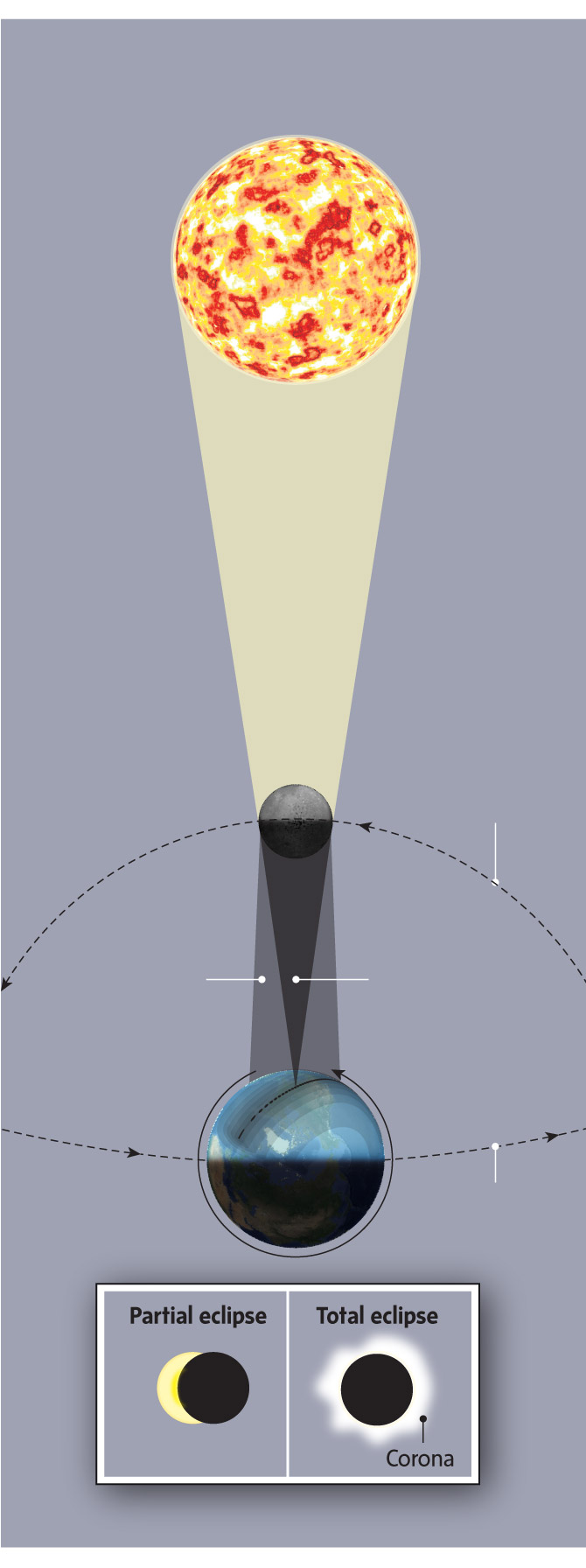
Moonshadows: The celestial geometry
behind a total solar eclipse
Sun
Moon
Moon’s
orbit
Partial eclipse
(penumbra)
Total eclipse
(umbra)
Earth
Earth’s
orbit
Partial eclipse
Total eclipse
Corona
*Diagram is not to scale.
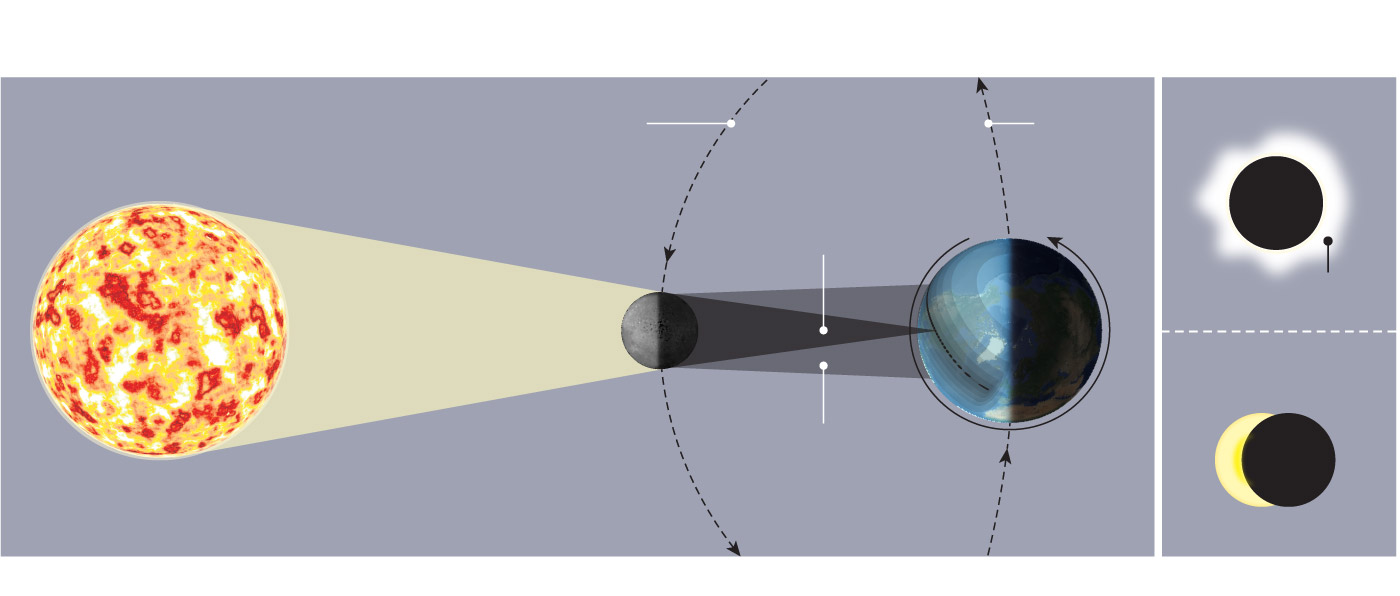
Moonshadows: The celestial geometry behind a total solar eclipse
Total eclipse
Earth’s
orbit
Moon’s
orbit
Total eclipse
(umbra)
Corona
Sun
Moon
Earth
Partial eclipse
Partial eclipse
(penumbra)
*Diagram is not to scale.
A cone of darkness
The total eclipse will be seen wherever the darkest part of the moon’s shadow – known as the umbra – makes contact with Earth’s surface.
The umbra is a long narrow cone that moves west to east, its precise path and speed dictated by the moon’s motion and the curvature and rotation of the planet. For this eclipse, the path is approximately 200 kilometres wide and the total eclipse will last longest for those who are nearest to the centreline.
The path has a long journey before it reaches Canada. The total eclipse begins at dawn in the south Pacific and it does not reach the mainland until just after 11 a.m. local time at Mazatlan, on Mexico’s west coast. Soon after, the eclipse hits its maximum duration of four minutes 28 seconds as the shadow passes near the city of Torreón.
From there, it heads to the U.S. border, crossing into Texas and then carving a swath up the Midwest to Ohio.

Total eclipse times and durations for
selected Canadian locations
(local times, p.m.)
ONT.
North
100 km
Toronto
Durations
30 seconds
U.S.
Hamilton
1 minute
Windsor
2 minutes
Niagara
Falls
3 minutes
Leamington
3:20
Central line
3:18
3:16
3:14 p.m.
(EDT)
Ottawa
Cornwall
Kingston
3:26
3:24
3:22 p.m.
(EDT)
PARTIAL
TOTAL
DURATION
PARTIAL
ECLIPSE
ECLIPSE
OF
ECLIPSE
BEGINS
BEGINS
TOTALITY
ENDS
Ontario
Leamington
1:58:39
3:13:43
2m 2s
4:28:04
Hamilton
2:03:56
3:18:12
1m 53s
4:31:12
Niagara Falls
2:04:53
3:18:20
3m 30s
4:32:00
Fort Erie
2:04:47
3:18:12
3m 44s
4:32:02
Kingston
2:09:32
3:22:16
3m 2s
4:34:28
Cornwall
2:12:35
3:25:01
2m 11s
4:35:58
North
Quebec
100 km
QUE.
Montreal
Lac-Mégantic
3:32
3:30
3:28 p.m.
(EDT)
PARTIAL
TOTAL
DURATION
PARTIAL
ECLIPSE
ECLIPSE
OF
ECLIPSE
BEGINS
BEGINS
TOTALITY
ENDS
Quebec
Montreal
2:14:29
3:26:55
1m 17s
4:36:52
Drummondville
2:16:07
3:28:32
35s
4:37:40
Sherbrooke
2:16:37
3:27:43
3m 25s
4:38:16
Lac-Mégantic
2:18:01
3:28:47
3m 27s
4:38:58
North
100 km
N.B.
Grand Falls
Les Îles-de-la-Madeleine
4:34 p.m.
(ADT)
4:36
4:40
Tignish
Fredericton
PEI
Moncton
Charlottetown
PARTIAL
TOTAL
DURATION
PARTIAL
ECLIPSE
ECLIPSE
OF
ECLIPSE
BEGINS
BEGINS
TOTALITY
ENDS
New Brunswick
Grand Falls
3:22:45
4:33:06
1m 27s
5:40:49
Hartland
3:22:43
4:32:24
3m 21s
5:43:13
Fredericton
3:23:43
4:33:50
2m 16s
5:41:55
Miramichi
3:25:27
4:34:24
3m 09s
5:42:15
Prince Edward Island
Tignish
3:27:12
4:35:45
3m 11s
5:43:10
Summerside
3:27:23
4:37:08
1m 04s
5:43:32
North
100 km
N.L.
Gander
5:14 p.m.
(NDT)
Bonavista
5:18
Clarenville
Channel-Port
Aux Basques
PARTIAL
TOTAL
DURATION
PARTIAL
ECLIPSE
ECLIPSE
OF
ECLIPSE
BEGINS
BEGINS
TOTALITY
ENDS
Newfoundland and Labrador
Channel-Port
4:02:52
5:09:59
2m 45s
6:15:26
Aux Basques
Gander
4:07:27
5:12:50
2m 13s
6:16:29
Clarenville
4:08:11
5:13:38
2m 31s
6:17:11
Bonavista
4:08:52
5:13:43
2m 53s
6:17:07
MURAT YÜKSELIR / THE GLOBE AND MAIL, SOURCE:
NASA; OPENSTREETMAP; FRED ESPENAK,
RASC OBSERVER’S HANDBOOK

Total eclipse times and durations for
selected Canadian locations
(local times, p.m.)
ONT.
North
100 km
Toronto
Durations
30 seconds
U.S.
Hamilton
1 minute
Windsor
2 minutes
Niagara
Falls
3 minutes
Leamington
3:20
Central line
3:18
3:16
3:14 p.m.
(EDT)
Ottawa
Cornwall
Kingston
3:26
3:24
3:22 p.m.
(EDT)
PARTIAL
TOTAL
DURATION
PARTIAL
ECLIPSE
ECLIPSE
OF
ECLIPSE
BEGINS
BEGINS
TOTALITY
ENDS
Ontario
Leamington
1:58:39
3:13:43
2m 2s
4:28:04
Hamilton
2:03:56
3:18:12
1m 53s
4:31:12
Niagara Falls
2:04:53
3:18:20
3m 30s
4:32:00
Fort Erie
2:04:47
3:18:12
3m 44s
4:32:02
Kingston
2:09:32
3:22:16
3m 2s
4:34:28
Cornwall
2:12:35
3:25:01
2m 11s
4:35:58
North
Quebec
100 km
QUE.
Montreal
Lac-Mégantic
3:32
3:30
3:28 p.m.
(EDT)
PARTIAL
TOTAL
DURATION
PARTIAL
ECLIPSE
ECLIPSE
OF
ECLIPSE
BEGINS
BEGINS
TOTALITY
ENDS
Quebec
Montreal
2:14:29
3:26:55
1m 17s
4:36:52
Drummondville
2:16:07
3:28:32
35s
4:37:40
Sherbrooke
2:16:37
3:27:43
3m 25s
4:38:16
Lac-Mégantic
2:18:01
3:28:47
3m 27s
4:38:58
North
100 km
N.B.
Grand Falls
Les Îles-de-la-Madeleine
4:34 p.m.
(ADT)
4:36
4:40
Tignish
Fredericton
PEI
Moncton
Charlottetown
PARTIAL
TOTAL
DURATION
PARTIAL
ECLIPSE
ECLIPSE
OF
ECLIPSE
BEGINS
BEGINS
TOTALITY
ENDS
New Brunswick
Grand Falls
3:22:45
4:33:06
1m 27s
5:40:49
Hartland
3:22:43
4:32:24
3m 21s
5:43:13
Fredericton
3:23:43
4:33:50
2m 16s
5:41:55
Miramichi
3:25:27
4:34:24
3m 09s
5:42:15
Prince Edward Island
Tignish
3:27:12
4:35:45
3m 11s
5:43:10
Summerside
3:27:23
4:37:08
1m 04s
5:43:32
North
100 km
N.L.
Gander
5:14 p.m.
(NDT)
Bonavista
5:18
Clarenville
Channel-Port
Aux Basques
PARTIAL
TOTAL
DURATION
PARTIAL
ECLIPSE
ECLIPSE
OF
ECLIPSE
BEGINS
BEGINS
TOTALITY
ENDS
Newfoundland and Labrador
Channel-Port
4:02:52
5:09:59
2m 45s
6:15:26
Aux Basques
Gander
4:07:27
5:12:50
2m 13s
6:16:29
Clarenville
4:08:11
5:13:38
2m 31s
6:17:11
Bonavista
4:08:52
5:13:43
2m 53s
6:17:07
MURAT YÜKSELIR / THE GLOBE AND MAIL, SOURCE:
NASA; OPENSTREETMAP; FRED ESPENAK,
RASC OBSERVER’S HANDBOOK
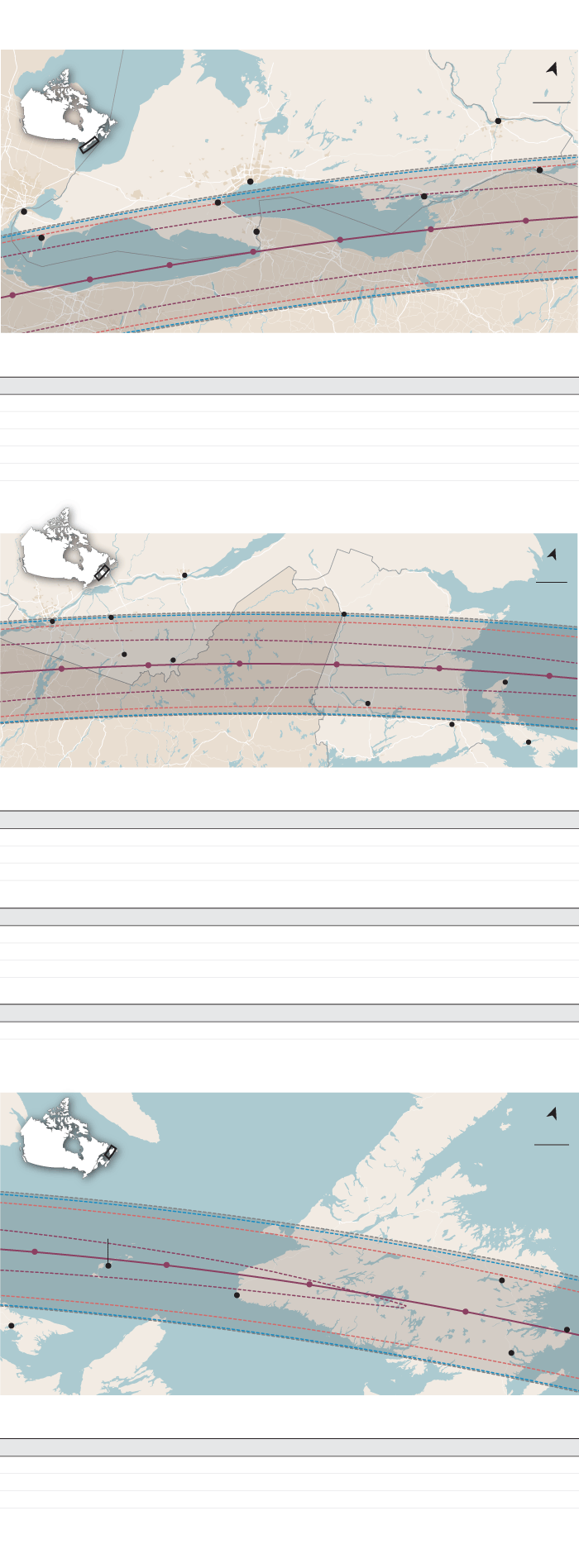
Total eclipse times and durations for selected Canadian locations
(local times, p.m.)
North
50 km
CANADA
Ottawa
ONT.
Cornwall
Toronto
Durations
30 seconds
U.S.
Kingston
1 minute
Hamilton
Windsor
2 minutes
3 minutes
3:26
Niagara Falls
Leamington
3:24
3:22
3:20
Central line
3:18
3:16
3:14 p.m.
(EDT)
PARTIAL
TOTAL
PARTIAL
ECLIPSE
ECLIPSE
DURATION OF
ECLIPSE
BEGINS
BEGINS
TOTALITY
ENDS
Ontario
Leamington
1:58:39
3:13:43
2m 2s
4:28:04
Hamilton
2:03:56
3:18:12
1m 53s
4:31:12
Niagara Falls
2:04:53
3:18:20
3m 30s
4:32:00
Fort Erie
2:04:47
3:18:12
3m 44s
4:32:02
Kingston
2:09:32
3:22:16
3m 2s
4:34:28
Cornwall
2:12:35
3:25:01
2m 11s
4:35:58
North
Quebec
50 km
QUE.
N.B.
Montreal
Grand
Falls
Drummondville
Lac-Mégantic
Sherbrooke
3:32
4:34 p.m.
(AST)
3:30
4:36
3:28 p.m.
(EDT)
Tignish
Fredericton
PEI
Moncton
Charlottetown
PARTIAL
TOTAL
PARTIAL
ECLIPSE
ECLIPSE
DURATION OF
ECLIPSE
BEGINS
BEGINS
TOTALITY
ENDS
Quebec
Montreal
2:14:29
3:26:55
1m 17s
4:36:52
Drummondville
2:16:07
3:28:32
35s
4:37:40
Sherbrooke
2:16:37
3:27:43
3m 25s
4:38:16
Lac-Mégantic
2:18:01
3:28:47
3m 27s
4:38:58
New Brunswick
Grand Falls
3:22:45
4:33:06
1m 27s
5:40:49
Hartland
3:22:43
4:32:24
3m 21s
5:43:13
Fredericton
3:23:43
4:33:50
2m 16s
5:41:55
Miramichi
3:25:27
4:34:24
3m 09s
5:42:15
Prince Edward Island
Tignish
3:27:12
4:35:45
3m 11s
5:43:10
Summerside
3:27:23
4:37:08
1m 04s
5:43:32
North
50 km
Les Îles-de-la-Madeleine
4:40 p.m.
(ADT)
4:42
N.L.
Gander
5:14 p.m.
(NDT)
Channel-Port
aux Basques
5:18
Charlottetown
Bonavista
Clarenville
N.S.
PARTIAL
TOTAL
PARTIAL
ECLIPSE
ECLIPSE
DURATION OF
ECLIPSE
BEGINS
BEGINS
TOTALITY
ENDS
Newfoundland and Labrador
Channel-Port Aux Basques
4:02:52
5:09:59
2m 45s
6:15:26
Gander
4:07:27
5:12:50
2m 13s
6:16:29
Clarenville
4:08:11
5:13:38
2m 31s
6:17:11
Bonavista
4:08:52
5:13:43
2m 53s
6:17:07
MURAT YÜKSELIR / THE GLOBE AND MAIL, SOURCE: NASA; OPENSTREETMAP; FRED ESPENAK, RASC OBSERVER’S HANDBOOK
The Canadian track
The umbra first touches Canada at the country’s southernmost point on Pelee Island. Here the total eclipse begins just before 3:15 p.m. local time. At this point the centreline of the path is hugging the south shore of Lake Erie, so Canadian locations on the north shore will see a total eclipse for about two minutes. This improves as the path slants north and eastward. The eastern third of Canada’s Erie shore and much of the Niagara Peninsula will get over three minutes at around 3:18 p.m.
The umbra then crosses Lake Ontario and reaches land again east of Toronto where Belleville, Kingston and Cornwall all lie within the path of totality. Downtown Montreal is also just inside, making it the largest Canadian city where residents will have a chance to see the total eclipse – though only for about one minute. The eclipse lasts longer for those who are south and east of Montreal. It’s there that the centreline of the eclipse finally enters Canada and skirts past Sherbrooke.
After cutting across Maine, the shadow re-enters Canada in New Brunswick, with totality beginning about 4:34 p.m. Atlantic time for Fredericton. Minutes later the eclipse darkens the western third of Prince Edward Island and the northernmost tip of Cape Breton Island before the Canadian journey concludes with a sprint across Newfoundland, from Channel Port Aux Basques to Bonavista, narrowly missing St. John’s. By then the sun will have sunk quite low in the west and the late-afternoon total eclipse will last just under three minutes on the centreline.
What about the weather?
“Nobody’s got a free ticket on this eclipse,” said eclipse weather guru Jay Anderson. That means even in the most favourable locations, there is some chance that the event will be clouded out. In general, the risk of clouds grows considerably once the shadow leaves the southern United States. It improves a bit around the Great Lakes then worsens into Quebec where the average cloud cover is greater than 70 per cent in early spring. New Brunswick and Newfoundland face the same odds, while prospects are slightly better for PEI.
But these are only statistical measures not predictions. Anyone hoping for clear skies should start checking forecasts about three days ahead of the eclipse and be prepared to shift plans if it means dodging unfavourable weather.
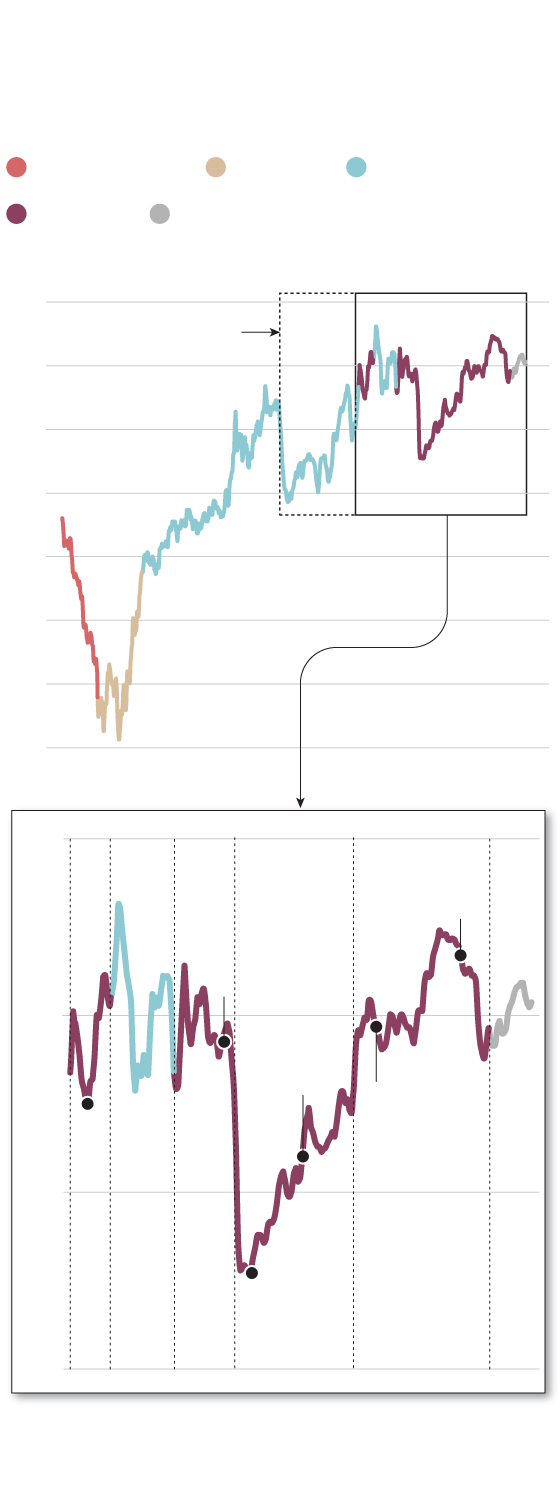
Eclipse weather prospects
Average frequency of April cloud cover along the central line of the 2024 total eclipse
Pacific Ocean
Mexico
U.S.
Canada
Atlantic Ocean
90%
Path of total
eclipse partly
in Ontario
80
70
60
50
40
30
20
90%
Que.
Maine
N.B.
Que. and
Gulf of Saint
Lawrence
N.L.
Gander
Miramichi
80
Îles de la
Madeleine
Stephenville
Sherbrooke
70
Tignish
60
THE GLOBE AND MAIL, SOURCE:
NASA; JAY ANDERSON
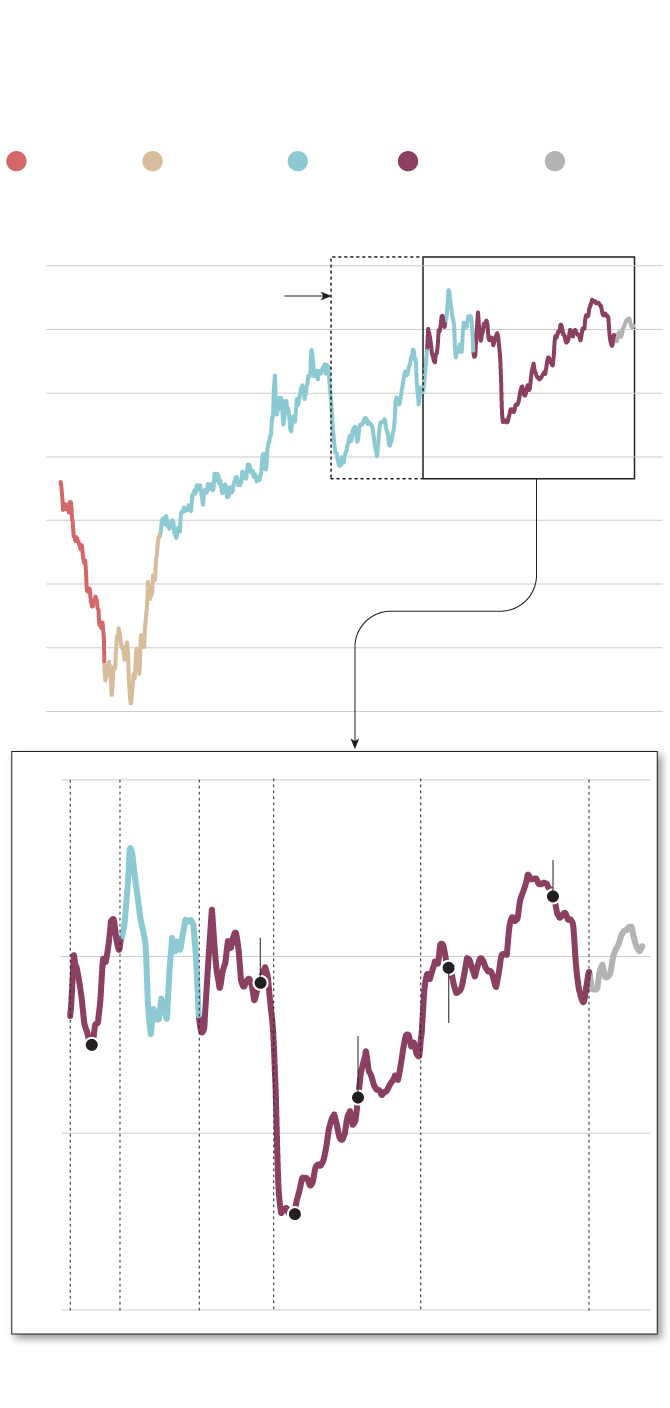
Eclipse weather prospects
Average frequency of April cloud cover along the central line of the 2024 total eclipse
Pacific
Ocean
Mexico
U.S.
Canada
Atlantic
Ocean
90%
Path of total
eclipse partly
in Ontario
80
70
60
50
40
30
20
90%
Que.
Maine
N.B.
Que. and
Gulf of Saint
Lawrence
N.L.
Gander
Miramichi
80
Îles de la
Madeleine
Stephenville
Sherbrooke
70
Tignish
60
THE GLOBE AND MAIL, SOURCE: NASA; JAY ANDERSON
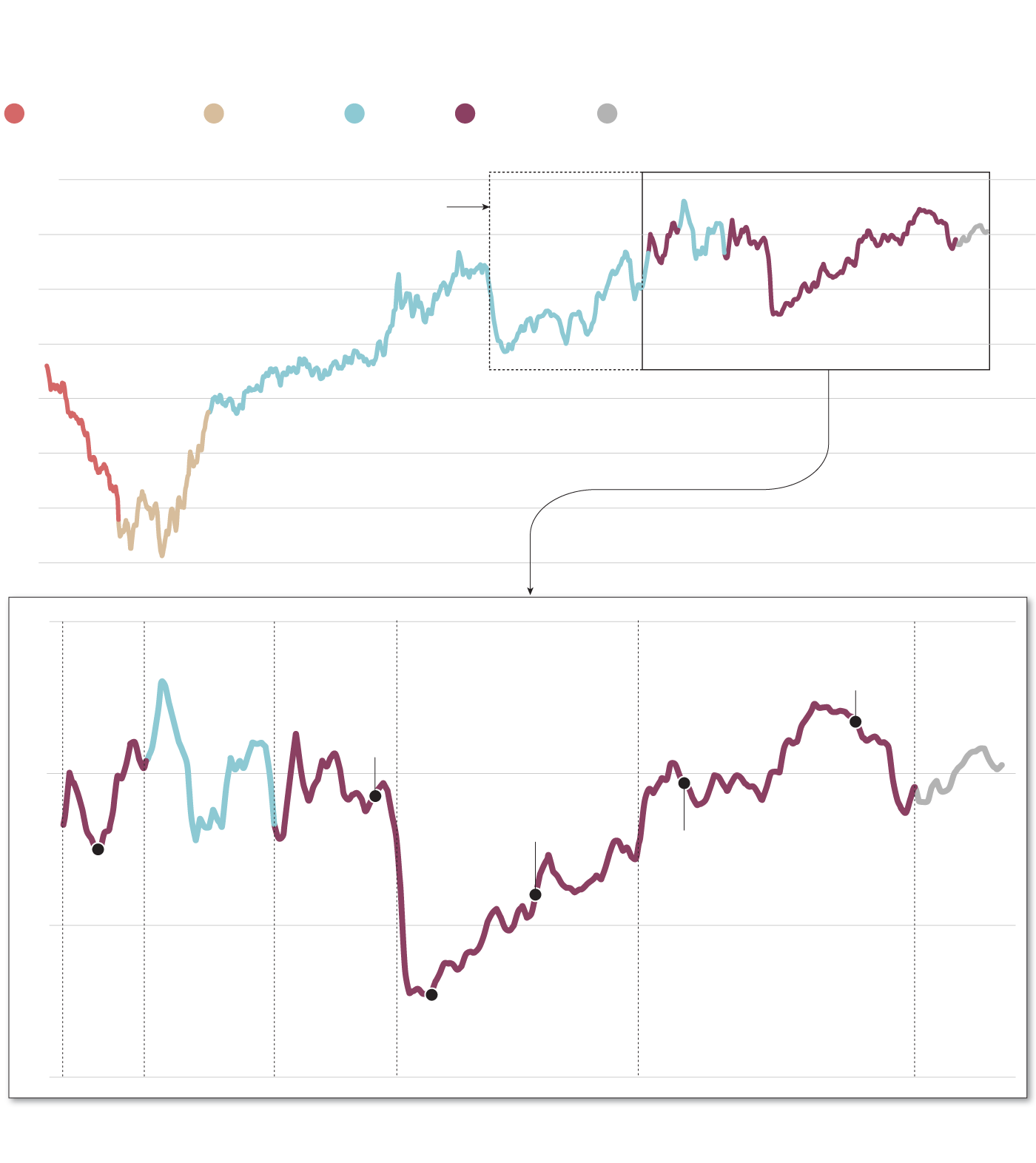
Eclipse weather prospects
Average frequency of April cloud cover along the central line of the 2024 total eclipse
Pacific Ocean
Mexico
U.S.
Canada
Atlantic Ocean
90%
Path of total
eclipse partly
in Ontario
80
70
60
50
40
30
20
90%
Que.
Maine
N.B.
Que. and
Gulf of Saint
Lawrence
N.L.
Gander
Miramichi
80
Îles de la
Madeleine
Stephenville
Sherbrooke
70
Tignish
60
THE GLOBE AND MAIL, SOURCE: NASA; JAY ANDERSON
Safety and equipment
It is never safe to look at the sun unprotected. This is true even when most of the sun’s surface is hidden, such as during a deep partial eclipse. Regular sunglasses, no matter how dark, do not provide sufficient protection from infrared solar rays that can cause permanent damage to the retina. To ensure safe viewing, the Canadian Association of Optometrists advises using solar eclipse glasses that meet the international standard ISO 12312-2. These should be ordered from a reputable supplier well before the event. The American Astronomical society has compiled a list of suppliers, including some that are based in Canada.
If you are using eclipse glasses, be sure they are not scratched or damaged. Do not use glasses with binoculars or telescopes, which require their own specialized solar filters.
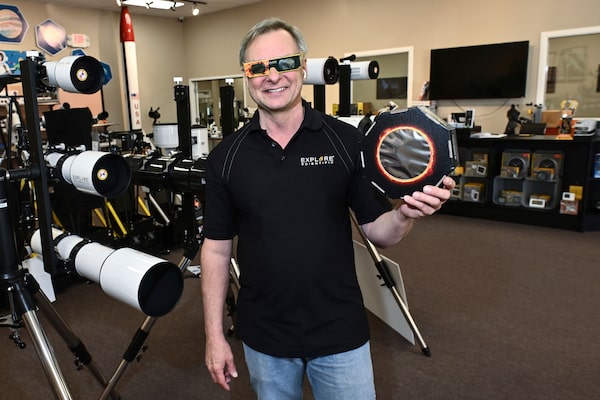
Scott Roberts, founder of Explore Scientific, demonstrates some of the eclipse glasses and large-aperture solar fixtures his store offers in Springdale, Ark. The store, and similar businesses in Canada, are on an American Astronomical Society list of reputable sellers of eclipse gear.Michael Woods/The Associated Press

Solar eclipse safety
Never observe the sun...
...directly
...through
binoculars, cameras,
smartphones
or telescopes
...through
coloured
plastic or
glass
....through
sunglasses
...in a reflective
surface like a
mirror, water
or chrome
...through a
film negative
DIY: Binocular projection
Set the focus knob of your binoculars to the middle range
Use binoculars to project two identical images of the sun onto a white surface about 30 cm away
To avoid overheating your binoculars don’t point them at the sun for more than a few minutes at a time
THE GLOBE AND MAIL

Solar eclipse safety
Never observe the sun...
...directly
...through binoculars,
cameras, smartphones
or telescopes
...through
coloured
plastic or
glass
....through
sunglasses
...in a reflective
surface like a
mirror, water
or chrome
...through a
film negative
DIY: Binocular projection
Set the focus knob of your binoculars to the middle range
Use binoculars to project two identical images of the sun onto a white surface about 30 cm away
To avoid overheating your binoculars don’t point them at the sun for more than a few minutes
at a time
THE GLOBE AND MAIL

Solar eclipse safety
Never observe the sun...
DIY: Binocular projection
...directly
...through binoculars,
cameras, smartphones
or telescopes
....through
sunglasses
...in a reflective surface
like a mirror, water
or chrome
Set the focus knob of your binoculars to the middle range
Use binoculars to project two identical images of the sun onto a white surface about 30 cm away
To avoid overheating your binoculars don’t point them at the sun for more than a few minutes at a time
...through coloured
plastic or glass
...through a
film negative
THE GLOBE AND MAIL
What do you want to know about the solar eclipse?
Globe science reporter Ivan Semeniuk is answering all your questions ahead of the April 8 solar eclipse. What is the path of totality? How can I watch it safely? How long will it last? Leave your questions below.